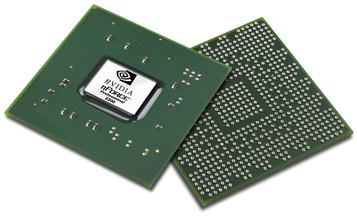NVIDIA nForce Professional Brings Huge I/O to Opteron
by Derek Wilson on January 24, 2005 9:00 AM EST- Posted in
- CPUs
The New nForce Professional
The nForce Professional marks the fifth core logic offering from NVIDIA, who dubs their motherboard chipsets MCPs (for Media and Communications Processors). Never has the MCP moniker been truer than this time around.
Like the the Quadro and GeForce line, the nForce line is supported by NVIDIA's Unified Driver Architecture. This means that no matter what hardware you are running, any driver will work, whether past present or future. Since NVIDIA brings its UDA to both Windows and Linux, broad corporate support will be available for nForce Pro upon launch.
NVIDIA has also informed us that they have been validating AMD's dual core solutions on nForce Professional before launch as well. NVIDIA wants its customers to know that it's looking to the future, but the statement of dual core validation just serves to create more anticipation for dual core to course through our veins in the meantime. Of course, with dual core coming down the pipe later this year, the rest of the system can't lag behind.
We've seen several good steps in the connectivity department. At the same time, performance and scalability have become more dependant on core logic as functionality moves over the PCI Express bus, more storage needs SATA connections, and more devices are plugged into USB ports, for example. NVIDIA's unique solution is the combination of single chip core logic with the ability to drop multiple MCPs (of lesser function) on a motherboard for expanded I/O capabilities.

The nForce Professional 2200 MCP
One of the big questions that we first wanted answered was whether or not nForce Pro and nForce 4 Ultra/SLI were the same silicon with different parts turned on/off. NVIDIA maintains that they are different silicon, and it is entirely possible that they are. They did, in fact, give us transistor counts for nForce 4 and nForce Pro:
nForce 4: 22 Million Transistors
nForce Pro: 24 Million Transistors
Economically, it still doesn't make sense to run two different batches of silicon when functionality is so nearly identical, especially when features could just be turned off after the fact. Pro chips don't have the same volume as desktop chips, and desktop chips don't have the same margins as pro silicon. Combining the two allows a company to produce more volume for a single IC (which lowers cost per part) that feeds both high volume and high margin SKUs. Of course, as we saw in our recent article on modding nForce Ultra to SLI, there are some issues with running all your chips from the same silicon. The fact that potential Quadro users have been buying and modding GeForce cards for years speaks to the issue as well. Of course, there's more in a Quadro than just professional performance (build quality and support/service come to mind).
But just because something doesn't make economic sense doesn't mean that we don't want to see it happen. There's just something that doesn't sit right about charging a thousand dollars more for a card that has a few features enabled. We would rather see professional parts be worth their price. Part of that equation is running separate silicon for parts with pro features. We're glad to hear that this is what NVIDIA has said they are doing here.
For now, let's get on to what we do know about the nForce Pro.










55 Comments
View All Comments
miketheidiot - Monday, January 24, 2005 - link
I'm impressed.ksherman - Monday, January 24, 2005 - link
Ill i can say is... DAMN! I wish i had the money do get one of these my self :(KristopherKubicki - Monday, January 24, 2005 - link
SDA: PCI-X is 64-bit PCI. PCI-Express also known as PCIe is a totally different animal. PCI-X is old, PCIe is new.Kristopher
SDA - Monday, January 24, 2005 - link
PCI-X is supposed to mean PCI-E, right? PCI-X != PCI-Express, now I'm confused...Anyway, looking good. Wonder what performance will be like.
CBone - Monday, January 24, 2005 - link
Sweet. Can't wait.